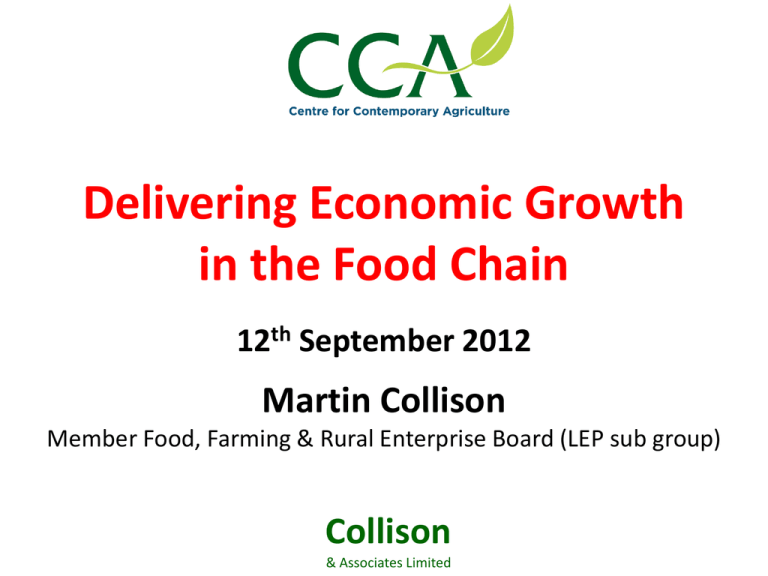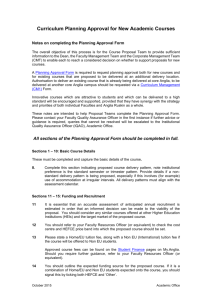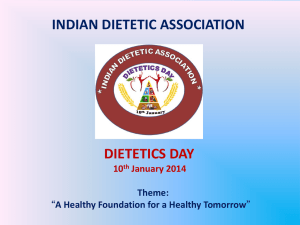Martin Collison
advertisement

Delivering Economic Growth in the Food Chain 12th September 2012 Martin Collison Member Food, Farming & Rural Enterprise Board (LEP sub group) Collison & Associates Limited The Partnership The Food Chain The perception of the food chain is that it is old fashioned, has poor career prospects and declining output unless you are a celebrity chef or into niche foods The Food Chain Truth is, the food sector: • Has been growing its GVA, exports and sales even during the recession • Share of economy has grown: 6.5% in (’07) to 7.0% (‘11) • Is high tech • Has excellent job prospects • Most of the sector is still focused on selling food via big retailers to the public The Food Chain in Suffolk & Norfolk The food chain is more important in Norfolk and Suffolk than for the UK economy as a whole New Anglia Food Chain has: • 120,000 employees (16% of the workforce); • A GVA of £4bn (15% of the economy); • Over 9,000 businesses directly in the food chain (not including catering and retail) • The largest agriculture sector of any LEP area, with: – 12% of the total agricultural output – and 16% of the profits in England Brands & Big Business Over 9,000 companies, 45+ UK leaders, HQ or £50m+ turnover: Adnams BOCM Pauls Favor Parker Lakeside Food group Pinguin Foods UK AFE Group Ltd British Sugar Foster Refrigeration Limagrain Premier Foods Anglia Maltings Colmans (Unilever) Greene King Little Chef Produce Investments Anglia Farmers Cranswick Gressingham Foods Manns (Class UK) Promens packaging Atlas Fram Country Foods Plc Heinz Frozen and Chilled Mars UK Robinsons Drinks (Britvic) Banham Poultry Crown Chicken J&H Bunn Muntons Plc Sam Cole Food Group Bayer Crop Science Dow Chemicals Kettle Foods (Lion Capital) Norfolk Food Company Sentry Farms Ben Burgess Duffields Kerry Foods Notcutts Smithfield Foods Ltd Bernard Matthews East of England Coop Kinnerton Pasta Food Ltd Tulip (BQP and Dalehead) Importance to the wider Economy As well as farming, food processing, catering and retail, the food chain impacts on many other parts of the economy, including: • 28% of road haulage is used in the food sector • 29% of tourism spending is on food and drink • 6% of UK exports by value R&D Norfolk & Suffolk is home to the largest concentration of agrifood R&D in the EU –Brooms Barn –CEEFAS –John Innes Centre –Institute of Food Research (IFR) –The Sainsbury Laboratory –The Genome Analysis Centre –Morley Research (NIAB TAG) –Universities and Colleges –Bayer, Dow, Limagrain, Thompson and Morgan and others Add in Cambs & Herts and arguably it has the largest concentration of agri-food related R&D in the World Careers The sector offers good careers: • Food processing employees stay nearly 10 years with each employer • Technology is changing job roles, with manual work declining rapidly as the demand for managerial, technical and automation skills increase • Farm managers have average salaries in excess of £45k plus benefits • Team leaders in fresh produce can command £30k by their mid 20s • Tractor drivers £35k, machinery worth over £250k, multiple computers • Agriculture in top 5 degree courses for employability (over 90% in 6mths) • Agriculture employment rose 10,000 during 2010-11 Recent job adverts: • £50-60,000 (Cambs) Senior Account Manager Food Sales • £45,000 OTE (East Anglia) Area Sales Manager: Agricultural Equipment • £35,000 + (Yorkshire / East Anglia) Crop Nutrition Agronomist • £20-25,000 (Suffolk) graduate horticultural trainee Food Sector Trajectory Growth: • GVA has grown 77% in UK agriculture since 2007 • UK food exports have grown for 7 consecutive years (‘04’11), now worth £18bn (up 70% since 2004) – but East of England not particularly strong in this area • New product development in the food sector was the highest ever last year with 8,500 UK product launches • R&D spending is increasing in the UK and globally as business and governments respond to growing demand • FAO has concluded $83bn needs to be invested annually in developing countries to feed the World in 2050, with R&D for yield the most important focus – an opportunity? The Global Food Challenge • Global population projected to grow 36% by 2050 • Land is being lost to urbanisation & due to climate change – Resources are becoming more limited and expensive: globally 75% freshwater is used for agriculture, under 2% in the UK – Nutrients in short supply and expensive • Climate and climate change – UK will be affected, but other areas potentially at more risk • Increasing wealth and changing diets – Global middle class will treble over ‘00-’30 to 3bn, more consumers with choice will demand more protein and added value foods – export potential is large and growing – Potential to export food products or knowledge and IP Pressure to increase output in areas suited to production Professor Sir John Beddington alerted us to… the “Perfect Storm…” Increased demand 45% by 2030 (IEA) Energy 1. Increasing population Climate Change 2. Increasing urbanisation 3. The rightful goal to alleviate poverty 4. Climate Change Putting food security into context Food Water Increased demand 50% by 2030 Increased demand 30% by 2030 (FAO) (IFPRI) Constraints on World Ag Production 40% too dry 21% too wet 21% too cold 6% too rough terrain 2% unsuitable soils The Need to Respond Despite our strength in the food chain, the sector is changing rapidly in the UK & investment is increasing across the World Doing nothing is not an option Delivering Economic Growth in the Food Chain Given the actual and projected long term Global increase in food demand we have to ride the wave We need to build on our strengths: 1. Business base – diverse & entrepreneurial 2. Climate & soil advantages 3. Location on the edge of a Global concentration of wealth (the EU’s golden triangle: London, Paris, Berlin) 4. Technical, scientific & NPD leadership on food production 5. Leadership on green issues, carbon, climate change, waste reprocessing, agri-environment Five Priorities Creating the Environment 1. Promoting R&D, knowledge transfer and skills as strategic imperatives, including: – – Supporting Otley & Easton College merger CCA, InCrops project and other collaborations 2. Creating a supportive investment environment: political, planning and policy, which supports: – – Development of modern infrastructure e.g. roads, broadband An outward looking globally engaged food economy 3. Securing productive resources: water, energy & nutrients – – Reservoirs AD plants utilising agricultural, commercial and municipal waste Five Priorities (cont.) Delivering Investment 4. Transformational Projects – large scale collaborative projects are needed to: – – Create globally competitive supply chains e.g. abattoirs, grain stores, farm coops for processing, food processing units Address resource questions e.g. water, nutrients 5. Aligning commercial and public sector investment in infrastructure, research, skills and facilities – – Apprenticeships project proposal led by Atlas Fram & Anglia Farmers Big opportunities for collaborative research funds to be accessed by more companies The Time is Now The Food Chain is: • Dynamic, exciting & growing • The largest business sector in the New Anglia area • A sector in which New Anglia is World Class • A sector with a large Global growth trajectory • Less exposed to recession than many other sectors Collectively we have to work together to make sure we can: • Grow its contribution to the economy to respond to growing global demand for food & associated technology • Invest in skills, R&D and businesses to deliver growth Thank you Martin Collison Centre for Contemporary Agriculture www.contemporaryagriculture.com martin@collisonassociates.co.uk (07802) 480 848











